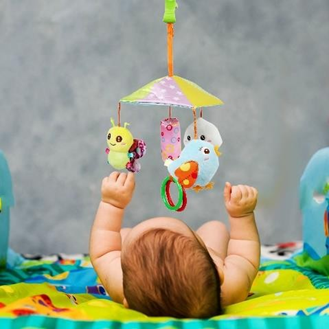A nurse is caring for a 12-month-old toddler who is hospitalized and confined to a room with contact precautions in place. Which of the following toys should the nurse recommend in orderto meet the developmental needs of the client?
Crayons and a coloring book
Hanging crib toys
Large building blocks
Modeling clay
The Correct Answer is B
A. Crayons and a coloring book: While coloring activities can be enjoyable and stimulating for toddlers, they may not be suitable for a hospitalized toddler in a confined room with contact precautions. Additionally, crayons and coloring materials may pose infection control risks.
B. Hanging crib toys: Hanging crib toys, such as mobiles or activity centers that attach to the crib, are suitable for stimulating visual and motor development in infants. They can provide entertainment and sensory stimulation for a hospitalized toddler in a confined room.

C. Large building blocks: Large building blocks are more suitable for older toddlers who have developed fine motor skills and coordination. They may not be appropriate for a 12-month-old toddler who is just beginning to explore objects and manipulate toys.
D. Modeling clay: Modeling clay presents a choking hazard and may not be suitable for a toddler who is still in the oral exploration stage. It is important to select toys that are age-appropriate and safe for a hospitalized toddler's developmental stage.
Nursing Test Bank
Naxlex Comprehensive Predictor Exams
Related Questions
Correct Answer is A
Explanation
A. Body weight: Body weight is the most reliable indicator of fluid loss, as changes in weight directly reflect changes in fluid balance. Monitoring weight is essential for assessing dehydration and guiding fluid replacement therapy.
B. Skin integrity: While changes in skin turgor and skin integrity can be indicators of
dehydration, they are less reliable in infants, especially if they have certain skin conditions or are very young.
C. Respiratory ratE. Although increased respiratory rate can occur as a compensatory mechanism for metabolic acidosis associated with dehydration, it is not as reliable as changes in body weight for assessing fluid loss.
D. Blood pressurE. While blood pressure may be affected by severe dehydration, it is not as sensitive or practical as monitoring body weight for assessing fluid loss in infants.
Correct Answer is A
Explanation
A. An infant's rate is 90 bpm.
An infant's normal heart rate typically ranges from 70 to 150
B. A toddler's rate is 150 bpm.
The normal heart rate for a toddler usually ranges from 70 to 130. Therefore a rate of 150 bpm would be considered tachycardia in a toddler.
C. A preschooler's rate is 130 bpm.
The normal heart rate for a preschooler typically ranges from 80 to 120 bpm, with an average rate around 100-110 bpm. A rate of 130 bpm would be considered tachycardia in a preschooler.
D. A school-age child's rate is 50 bpm.
The normal heart rate for a school-age child usually ranges from 75 to 118 bpm. A rate of 50 bpm would be considered bradycardia in a school-age child.
Whether you are a student looking to ace your exams or a practicing nurse seeking to enhance your expertise , our nursing education contents will empower you with the confidence and competence to make a difference in the lives of patients and become a respected leader in the healthcare field.
Visit Naxlex, invest in your future and unlock endless possibilities with our unparalleled nursing education contents today
Report Wrong Answer on the Current Question
Do you disagree with the answer? If yes, what is your expected answer? Explain.
Kindly be descriptive with the issue you are facing.
